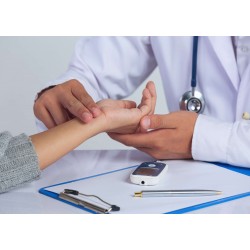PERSONAL BLOG
Cardiovascular Examination (OSCE)
Cardiovascular Examination - OSCE Demonstration
Introduction
- Greet the patient and introduce yourself 👋
- Explain the procedure in a patient friendly manner
- Get patient consent
- Wash hands 🖐
- Set the head of the bed to a 45° angle 📐
- Expose the patient’s chest for examination and their lower legs to asses for peripheral oedema/ peripheral vascular disease
- Check the patient is not in any pain
General Inspection of the patient
Check for any clinical signs that may indicate pathology, for example:
🏨 Oedema: swelling of limbs or abdomen – most likely to be caused by congestive heart failure
🏨 Pallor: pale skin – can indicate anaemia or perfusion
🏨 Cyanosis: bluish skin – due to poor circulation or low blood oxygenation
🏨 Malar flush: plum-red cheeks – mitral stenosis
🏨 Shortness of breath: may be cause by respiratory or cardiovascular disease
Check for objects which may reveal useful information, for example:
🏨 Prescriptions: provides information about the recent medical history of the patient
🏨 Pillows: orthopnoea prevents patients with congestive heart failure lying flat
🏨 Medical equipment: e.g. oxygen delivery devices, catheters, intravenous access, ECG leads and medications
🏨 Vital signs: show their current clinical status and how this has changed over time
🏨 Mobility aids: wheelchairs/ walking aids ♿
🏨 Fluid balance: charts reveal current fluid status to allow dehydration of fluid overloading to be identified
Inspection of patient’s hands
Identify any clinical sings that can be relevant to the cardiovascular system:
‘Spider fingers’ (Arachnodactyly): abnormally long and slender fingers compared to the palm of hands
🏨 Indicates Marfan’s syndrome, associated with mitral/aortic valve prolapse and aortic dissection
Tar staining: caused by smoking
🏨 Significant cardiovascular disease risk factor
Colour:
🏨 Pallor indicates poor peripheral perfusion
🏨 Cyanosis indicates hypoxaemia
Xanthomata: raised, yellow, cholesterol rich deposits on the palm, wrist tendons and elbow
🏨 Can indicate hyperlipidaemia which is another significant risk factor for cardiovascular disease
Assess the patient for finger clubbing:
- Ask patient to place their index finger nails back to back
- If there is no small, diamond shaped window, this is known as clubbing
🏨 Clubbing is associated with several underlying diseases, notably, congenital cyanotic heart disease, infective endocarditis and rarely, atrial myxoma
🏨 Other signs in the hand associated with endocarditis: splinter haemorrhages, Janeway lesions and Osler’s nodes

Palpation:
Assess patient’s temperature: assess patient’s temperature using the dorsal aspect of your hand.
🏨 Healthy individuals will be symmetrically warm
🏨 Cold hands can indicate poor peripheral perfusion ❄
🏨 Sweaty hands can indicate acute coronary syndrome
Measure capillary refill time: apply pressure to the distal phalanx for 5 seconds
🏨 In healthy individuals, the pallor will return to normal colouration after 2 seconds
🏨 If it takes more than 2 seconds, it indicates poor peripheral perfusion and central capillary refill time must be assessed
Pulses and blood pressure
Radial Pulse:
Palpate the patient’s radial pulse with your fingertips to asses rate and rhythm:
🏨 Heart rate: measure for 60 seconds
🏨 In healthy individuals: 60-100bpm
🏨 Bradychardia: <60bpm
🏨 Tachycardia: >100bpm
🏨 Atrial fibrillation is the most common cause of an irregular rhythm
🏨 Radio-radial delay: when the pulse on each arm is not synchronised. This is assessed by palpating both radial pulses simultaneously
🏨 Causes: aortic dissection, aortic coarction or subclavian artery stenosis
🏨 Collapsing pulse: a forceful pulse which rapidly increase before collapsing. This is assessed by:
- Check if the patient has any pain in their right shoulder
- Place your right hand around their wrist and palpate the radial pulse
- Use your left hand to palpate the brachial pulse
- Briskly lift the arm above their head
- Palpate to check for a collapsing pulse
🏨 A collapsing pulse can be caused by: high output states, cardiac lesions or normal physiological states
Brachial pulse:
🏨 Take the patient’s right arm and palpate the brachial pulse to assess the volume and character:
- Use your left hand to support the patient’s right forearm
- The patient should have their upper arm abducted, partially flex their elbow and rotate their forearm externally
- Use your right hand to palpate in the middle of the biceps brachii tendon, to the side of the humerus’ medial epicondyle
🏨 Characteristics: normal, slow-rising (aortic stenosis), bounding (aortic regurgitation or CO2 retention), thready (intravascular hypovolaemia)
Blood pressure:
🏨 Measure the blood pressure of the patient in both arms (lying and standing) to identify any abnormalities, for example:
🏨 Hypertension: ≥ 140/90 mmHg under 80 y/o or ≥ 150/90 mmHg over 80 y/o
🏨 Hypotension: < 90/60 mmHg
🏨 Narrow pulse pressure: < 25 mmHg difference between systolic blood pressure and diastolic blood pressure, can be caused by aortic stenosis, cardiac tamponade or congestive heart failure
🏨 Wide pulse pressure: > 100 mmHg difference between systolic blood pressure and diastolic blood pressure, can be caused by aortic dissection or aortic regurgitation
🏨 Difference between arms: > 20 mmHg difference is abnormal and can indicate aortic dissection
Carotid Pulse:
🏨 This is located between the larynx and the sternocleidomastoid muscle anterior border
🏨 Auscultate the carotid artery: to rule out the presence of bruit (suggests carotid stenosis), you must auscultate the vessel before you palpate the carotid artery, which could otherwise be dangerous
- Place stethoscope between larynx and sternocleidomastoid muscle anterior border (over the carotid pulse)
- Ask the patient to take a deep breath
- Palpate the carotid pulse if no bruits were identified
- Position patient safely on bed
- Place fingers between larynx and sternocleidomastoid muscle anterior border to identify the carotid pulse
- Assess the volume and character of the carotid pulse
Jugular venous pressure (JVP)
Measure JVP:
🏨 This allows you to indirectly measure the central venous pressure because a continuous column of blood connects the internal jugular vein (IJV) to the right atrium
- Position the patient at a 45° angle
- Ask them to turn their head left slightly
- Inspect between the clavicle and earlobe for evidence of the IJV (IJV has a double waveform pulsation and so you should be able to distinguish between it and the external carotid artery)
- Measure the distance between the sternal angle and the top of the IJV pulsation point (should be ≤ 3cm) – this is the JVP
🏨 If the JVP is raised, it indicated venous hypertension which is caused by: right side heart failure, tricuspid regurgitation, or constrictive pericarditis
Hepatojugular reflux test:
🏨 Apply pressure to the liver whilst you observe the IJV for a rise which indicates a rise in JVP
🏨 In healthy patients, the rise will only last 1-2 cardiac cycles
🏨 ≥ 4cm JVP and >1-2 cardiac cycles is considered a positive result
🏨 A positive result indicates that the right ventricle cannot accommodate an increased venous return but does not enable you to diagnose a specific cause
Facial examination
Inspect the eyes as they can reveal relevant signs:
🏨 Xanthelasma: yellow deposits rich in cholesterol which can indicate hypercholesterolaemia
🏨 Conjunctival pallor: indicates anaemia
🏨 Kayser-Fleischer rings: when the iris in encircled with dark rings, indicates Wilson’s disease
🏨 Corneal arcus: when the peripheral cornea contains a white, grey or blue ring, in under 50s this can indicate hypercholesterolaemia
Inspect the mouth as it can reveal relevant signs:
🏨 Poor dental hygiene: risk factor for infective endocarditis
🏨 Angular stomatitis: inflamed corners of mouth can indicate iron deficiency
🏨 Central cyanosis: bluish colour can indicate hypoxaemia
🏨 High arched palate: suggest Marfan syndrome
Closely inspect the chest
🏨 Anterior chest inspection to identify medical history clues, such as scars suggesting the patient has had past thoracic surgery, pectus excavatum, pectus carinatum, visible pulsations
🏨 Median sternotomy scar: coronary artery bypass grafts
🏨 Anterolateral thoracotomy scar: minimally invasive cardiac valve surgery
🏨 Left mid-axillary scar: implantable cardioverter-defibrillator
🏨 Infraclavicular scar: pacemaker insertion
Palpation
Identify the location of the apex beat by palpating the chest:
🏨 Typically in the midclavicular line in the 5th intercostal space
🏨 Displacement caused by ventricular hypertrophy
Identify heaves by palpating the chest:
🏨 Parasternal heave is a precordial impulse
- Place heal of hand in parallel position to the left sternal edge to palpate
- If you feel your hand is lifted at each systole, heaves are present
🏨 Heaves are caused by right ventricular hypertrophy
Identify thrills by palpating the chest:
🏨 Thrills are turbulent blood flow through a heart valve which causes palpable variations
🏨 Each of the valves of the heart must be assessed for thrills, by placing your hand horizontally across the wall of the chest and placing you fingers and palm flat over the valve you are checking
Auscultation of the four heart valves
- Determine the first heart sound 👂 by palpating the carotid pulse initially
- Move ‘upwards’ through the 4 valves as you auscultate each, continuing to palpate the carotid pulse, using the diaphragm of the stethoscope first then repeat with the bell
Finishing the examination
Inspect the posterior chest wall:
🏨 You are looking for any scars or deformities
Posteriorly auscultate the lung fields:
🏨 If you identify ‘coarse crackles’ it is likely pulmonary oedema
🏨 If you identify absent air entry and stony dullness, it is likely pleural effusion
Inspect the sacrum and palpate:
🏨 To identify pitting oedema
Inspect the patient’s ankles and palpate:
🏨 To identify pitting pedal oedema
Inspect the patient’s legs:
🏨 To identify saphenous vein harvesting
The end of the examination
- Explain the examination is finished and thank the patient
- Wash hands 🖐
- Summarise the findings of the examination
Summary:
- Greet the patient and briefly explain the procedure
- Inspect the patient to identify any clinically relevant signs
- Assess for finger clubbing
- Assess the patient's temperature and capillary refill time
- Assess the radial, brachial and carotid pulses and blood pressure
- Measure the Jugular Venous Pressure, and perform the Hepatojugular reflux test
- Inspect the eyes, mouth and chest to identify anything clinically relevant
- Palpate the chest to identify the location of the apex beat, heaves and thrills
- Auscultate the 4 heart valves
- Inspect the posterior chest wall, sacrum and ankles; palpate the sacrum and ankles; auscultate the lung fields
- Complete the procedure by thanking the patient and summarising your findings
Related Articles
This step by step guide is designed to take you through the 5A’s approach to smoking cessation counselling in OSCEs.
This step by step guide is designed to take you through the peripheral vascular examination in OSCEs.















